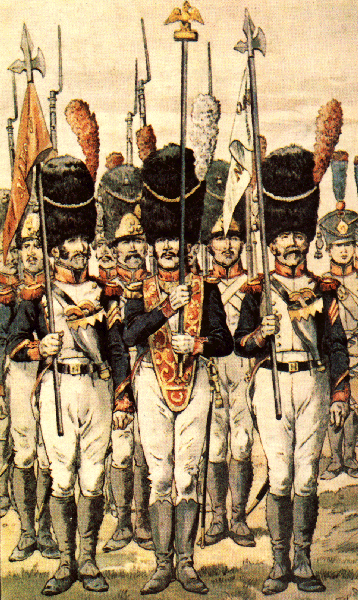| Following the decree for the first amalgame, or embrigadement, of 1793, the Comite de la Guerre charged General Etienne-Nicolas de Calon to devise a plan for new flags and standards to go with the reorganized armed forces of France. The new guidelines suggested by Calon and adopted by the Convention had their design roots in the regimental flags of the existing army that had been authorized by the National Assembly in 1791, where the senior battalion carried an updated version of the colonel's flag, while the junior battalions of each regiment carried identical-pattern red, white and blue colors that were unique to each regiment. The flags measured 160cm x 160cm and were carried on staffs painted in white, red and blue spirals topped by a brass pike head to which tricolour cravats, cords and tassels were attached.
In 1804 Napoleon issued the famous eagles to his regiments and the actual flag was now of secondary importance to the eagle itself. The new flags issued at this time measured approx 80cm square and each battalion and squadron of the French army received one of these flags. In September 1806 it was officially laid down that Light infantry units should hand in all their eagles at the begining of a campaign, however it is on record that at least one Light regiment lost its eagle in battle as late as 1814. In 1808 it was decreed that only one eagle was to be carried per regiment and that by the 1st battalion, the eagles and flags of the other battalions were to be returned to the regimental depots. This took some time to be implemented and some 2nd and 3rd battalions still had their colours in the field as late as 1811. The new flags were nailed with glit headed studs to a blue wooden staff, 3cm in diameter and 2m 10cm long (including the eagle itself). Double gold cords and tassels were attached immediately below the eagle.
From April 1812 each Line and Light regiment received a single new tricolour pattern standard which bore on the reverse the battle honours of the regiment. The battle honours were restricted to those battles at which Napoleon had commanded in person i.e. Ulm, Austerlitz, Jena, Eylau, Friedland, Eckmuhl, Essling and Wagram. The new flags measured 80cm x 80cm and had a 2.5cm wide gold fringe. A tricolour cravat measuring 92cm long by 16cm wide with gold fringes was attached to the flagstaff immediately below the eagle.
In 1815 after Napoleons return from exile, the regiments received new flags and eagles. The flags now measured 120cm x 120cm and were of a much more simple design. Most regiments displayed the same battle honours as for the 1812 pattern and the tricolour cravat was still attached immediately below the eagle. Throughout the period 1804-1815 each Eagle-bearer (porte-aigle) was accompanied by two senior NCO escorts who carried halberds. Triangular streamers or Fanions measuring approx 61cm x 20cm were attached to these halberds, red for that to the right of the Eagle-bearer, white to the left, both with gold lettering. |








